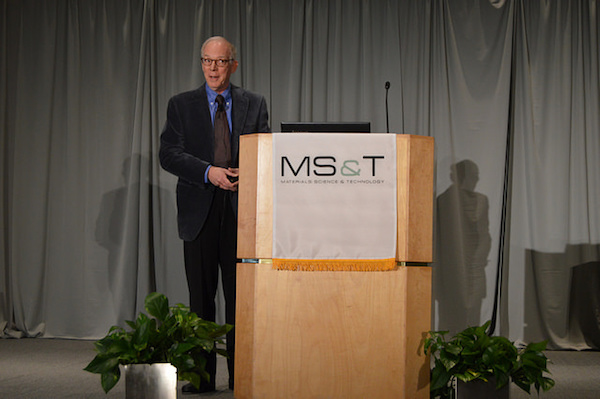
[Image above] Students at ASM Materials Camp learn about the heat-resistant properties of refractories. Credit: ACerS
MS&T16 ended yesterday, bringing to a close the annual flagship event in materials science and engineering. The technical program is the centerpiece of MS&T, but it also hosts the annual membership meetings of The American Ceramic Society and ASM International. All four partner societies also hold myriad award lectures, committee meetings, business meetings, protocol events, and student activities. Bringing together 3,000 people with common interests led to pop-up meetings to discuss science, share results, begin collaborations, and do business.
Attendees had the opportunity to visit the exhibit hall, talk to vendors, and view student posters. ASM’s Materials Camp brought students from area middle and high schools to introduce them to the exciting world of “stuff” that we call materials science. The Refractory Ceramics Division and Ceramic and Glass Industry Foundation provided demonstrations showing the insulating properties of refractory brick, glass viscosity with a candy pull, and the always-popular liquid nitrogen demonstrations.
In short, it was a typical MS&T—stimulating, interdisciplinary, interesting, and busy.
This is the second year in which the plenary session comprised three society award lectures. ACerS presents its Edward Orton, Jr. Memorial Lecture in the plenary, and this year the speaker was Bruce Dunn, Nippon Sheet Glass Professor of Materials Science and Engineering at University of California, Los Angeles. His talk, “Designing Ceramics for Next-Generation Energy Storage Systems,” focused on batteries, supercapacitors, and pseudocapacitors.
“In many ways the consumer market is driving energy storage,” Dunn says, although other markets include automotive, military, medical devices (hearing aids, defibrillators, etc.), and the power grid. Regarding the last item and renewable energy, Dunn says, “Anytime you see renewables, you have to think of energy storage. They are just-in-time systems. You have to think about storage.”
And where to store that energy comes down to the trade-offs between energy density and power density.
The lithium battery industry is huge—Dunn says it’s on track to reach $119.3 billion by 2020. But the technology is imperfect, as recent episodes with the Samsung Galaxy Note 7 demonstrated. The dramatic explosions and fires occurred in the liquid electrolyte of the battery. Switching to a solid electrolyte will prevent the combustibility problem, but the cathode is the energy-limiting component, as well as the solid–solid interface between electrolyte and cathode.
New cathode materials such as sulfates could play a role, and so could new core–shell such as carbon shells on LiFePO4 shells. Candidate materials for solid electrolytes include materials such as Li7La3Zr2O12 and exotic nonoxides such as Li10GeP2S (which boasts the highest reported conductivity of any solid electrolyte).
The market, though, clamors for technologies that charge faster and power devices for longer service times. For example, Tesla wants to be able to recharge a vehicle in five minutes—about the time it takes to pump a tank of gasoline.
To reach the energy and power capacities that the market demands, researchers are exploring alternatives such as supercapacitors and pseudocapacitors.
“What’s important is that we are beginning to blur the distinction between batteries and capacitors,” Dunn says.
Interesting materials to keep an eye on for future pseudocapacitor technology include MoO2, which has metallic conductivity, but at the price of a monoclinic–orthorhombic phase transition. Dunn says the phase transition doesn’t occur at the nanoscale, leading researchers to look at graphene and composite materials such as MoO2–RGO (reduced graphene oxide). Other candidate materials include exfoliated 2-D materials, mesoporous materials, and oxygen deficient transition metal oxides, such as MoO2.75
Dunn stayed in the realm of materials and properties without addressing processing. He may want to talk to Sosman Award Lecturer Jennifer Lewis, professor at Harvard’s School of Engineering and Applied Science.
Lewis’s talk, “Programmable Assembly of Colloidal Suspensions,” summarized the latest developments in her seminal work on 3-D printing of ceramic materials, which included printing some prototype batteries. She admitted they weren’t very good yet. But with Lewis and Dunn providing proof of concept work, we may see major changes in the way we carry around and access power before long.
It’s not too soon to start planning for MS&T17 in Pittsburgh, Pa., Oct 8–12, 2017. Stay tuned!

Bruce Dunn, UCLA professor, showed the audience at MS&T’s plenary session the roles ceramic materials will play in the next generation of energy storage devices. Credit: ACers

Jennifer Lewis, Harvard University, presented her teams work on colloidal suspensions for 3-D printing at the Sosman Award Lecture on Wednesday. Credit: ACerS
